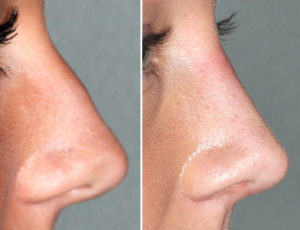Background: The shape of the nose has clear gender differences and preferences. Most of these are classically known and are also influenced by ethnicity, culture and age of the patient. By contemporary beauty trends that are highly influenced by social media, many young females today are seeing very small and refined noses. They will often desire a more concave dorsal profile as well as an upturned and narrow tip. Also because of social media and being able to do one’s own image manipulations through a variety of online applications, younger females are often very specific about their rhinoplasty goals.
One of the known predictors of rhinoplasty success is whether one has the preoperative anatomy that has any chance to achieve the postoperative nasal shape goals. In many cases the skin is too thick and/or the osteocartilaginous structures are too big to allow for the desired refined and much smaller nasal shape result. But the primary key is the thickness of the nasal skin. It is hard to bypass how well the skin will thin or adapt to the what has been reshaped underneath it.
But in the right female nose with average to thin skin, a refined or finesse rhinoplasty change is possible.
Case Study: This thin young female wanted a smaller and more refined nose shape. She didn’t like her nasal hump and wanted the tip narrowed but not lifted any further…but didn’t want the nose to look like it been surgically changed.


Highlights:
1) Many rhinoplasties do not involve large nasal changes but rather a collection of more subtle maneuvers that create the overall effect. (finesse rhinoplasty)
2) Many women prefer a less than straight dorsal line and a slightly upturned nasal tip.
3) Smaller changes in the nose often take longer to see the final result awaiting complete resolution of all swelling and skin contraction.
Dr. Barry Eppley
Indianapolis, Indiana



